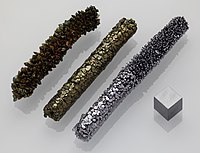
Photo from wikipedia
The reactions of CS2 captured by intramolecular geminal G13/P-based (G13 = group 13 elements) and Ga/G15-based (G15 = group 15 elements) frustrated Lewis pairs have been theoretically examined by using… Click to show full abstract
The reactions of CS2 captured by intramolecular geminal G13/P-based (G13 = group 13 elements) and Ga/G15-based (G15 = group 15 elements) frustrated Lewis pairs have been theoretically examined by using density functional theory (DFT) computations. With regard to the nine FLP-related compounds, our DFT calculated results reveal that only Al/P-Rea and Ga/P-Rea can kinetically and thermodynamically precede the energetically feasible combination reactions with CS2 to form the five-membered heterocyclic adducts. Our activation strain model analyses on the nine aforementioned model molecules indicate that the atomic radius of the Lewis acceptor (G13) and the Lewis donor (G15) plays a role in controlling their barrier heights to obtain good orbital overlaps among G13/P-Rea, Ga/G15-Rea, and CS2. Our theoretical observations based on the energy decomposition analysis-natural orbitals for chemical valence (EDA-NOCV) approach strongly indicate that the donor-acceptor bonding (i.e., singlet-singlet bonding) rather than the electron-sharing bonding (i.e., triplet-triplet bonding) plays a central role in determining the bonding conditions of the transition states, G13/P-TS and Ga/G15-TS. In addition, the theoretical evidence obtained by the frontier molecular orbital theory and EDA-NOCV analyses reveals that the best description for the bonding natures of the combination reactions of intramolecular geminal G13/P-Rea and Ga/G15-Rea with CS2 is the lone pair(G15) → p-π*(C) interaction rather than the p-π*(G13) ← p-π(S) interaction. Moreover, our present DFT computations concerning the calculated structures and corresponding relative energetics of the stationary points connected with the aforementioned sophisticated approaches are in accordance with the Hammond postulate.
Journal Title: Inorganic chemistry
Year Published: 2022
Link to full text (if available)
Share on Social Media: Sign Up to like & get
recommendations!